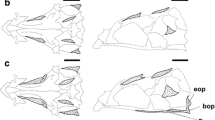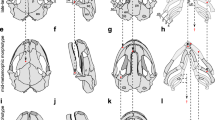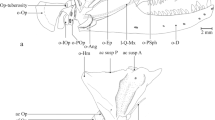Abstract
The osteological development of elements forming the oral cavity was examined in early stage larvae of the grouper,Epinephelus coioides, from hatching to 242.5 hours after hatching. By the time of initial mouth opening, at 54 hours after hatching, the fundamental elements, composed of the trabecula, some components of the lower branchial and hyoid arches, the quadrate and symplectic-hyomandibular cartilages, maxilla and Meckel's cartilage, had appeared. No further elements were observed until 165 hours after initial mouth opening, except some components in the lower branchial arch and head region. The appearance of new elements and initial ossification of existing cartilage occurred thereafter, but all elements related to feeding either had not appeared or had not started ossifying until 188.5 hours after initial mouth opening. Based on the morphology and developmental modes of these elements, the feeding mode of grouper larvae was considered to be “sucking/grasping.” However, the appearance and ossification of elements occurred slowly, with no transitional phase from sucking to grasping modes of feeding being observed during the study; such delayed development of the feeding-related bony elements was considered to be a cause of the difficulty in rearing early stage grouper larvae.
Similar content being viewed by others
Literature Cited
Anonymous. 1987. Grouper abstracts. Bibliography No. 8, BRAIS/SEAFDEC AQD, Iloilo, Philippines. xv+95 pp.
Dingerkus, G. and L. D. Uhler. 1977. Enzyme clearing of alcian blue stained whole small vertebrates for demonstration of cartilage. Stain Technol., 52: 229–232.
Doi, M., M. N. Munir, N. L. Nik Razali and T. Zulkifli. 1991. Artificial propagation of the grouper,Epinephelus suillus at the marine finfish hatchery in Tanjong Demong, Terrengganu, Malaysia. Kertas Pengembangan Perikanan, (167), Department of Fisheries, Malaysia, 41 pp.
Hussain, N. A. and M. Higuchi. 1980. Larval rearing and development of the brown spotted grouper,Epinephelus tauvina (Forskål). Aquaculture, 19: 339–350.
Kayano, Y. 1988. Development of mouth parts and feeding in the larval and juvenile stages of red spotted grouperEpinephelus akaara. Bull. Okayama Pref. Fish. Exp. Stn., 3: 55–60. (In Japanese).
Kohno, H., S. Diani, P. Sunyoto, B. Slamet and P. T. Imanto. 1990. Early developmental events associated with changeover of nutrient sources in the grouper,Epinephelus fuscoguttatus, larvae. Bull. Pen. Perikanan, Spec. Edit., No. 1: 51–64.
Kohno, H., A. Ohno and Y. Taki. 1994. Why is grouper larval rearing difficult?: a comparison of the biological natures of early larvae of four tropical marine fish species. Pages 450–453in L. M. Chou, A. D. Munro, T. J. Lam, T. W. Chen, L. K. K. Cheong, J. K. Ding, K. K. Hooi, H. W. Khoo, V. P. E. Phang, K. F. Shim and C. H. Tan, eds., The third Asian fisheries forum, Asian Fish. Soc., Manila, Philippines.
Kohno, H., R. Ordonio-Aguilar, A. Ohno and Y. Taki. 1996a. Osteological development of the feeding apparatus in early stage larvae of the seabass,Lates calcarifer. Ichthyol. Res., 43: 1–9.
Kohno, H., R. Ordonio-Aguilar, A. Ohno and Y. Taki. 1996b. Morphological aspects of feeding mode and improvement of feeding ability in early stage larvae of the milkfish,Chanos chanos. Ichthyol. Res., 43: 133–140.
Lim, L. C. 1991. Larviculture of the greasy grouper (Epinephelus tauvina F.) and brown-marbled grouper (E. fuscoguttatus F.) in Singapore. Pages 321–322in P. Lavens, P. Sorgeloos, E. Jaspers and F. Ollevier, eds. Larvi '91—Fish & crustacean larvicultures symposium, European Aquaculture Soc., Special Publ. No. 15, Gent, Belgium.
Matsuoka, M. 1987. Development of the skeletal tissue and skeletal muscles in the red sea bream. Bull. Seikai Reg. Fish. Res. Lab., (65): 1–114.
Ordonio-Aguilar, R., H. Kohno, A. Ohno, M. Moteki and Y. Taki. 1995. Development of grouper,Epinephelus coioides, larvae during changeover of energy sources. J. Tokyo Univ. Fish., 82: 103–108.
Otten, E. 1982. The development of a mouth-opening mechanism in a generalizedHaplochromis species:H. elegans Trewavas 1933 (Pisces, Cichlidae). Neth. J. Zool., 32: 31–48.
Author information
Authors and Affiliations
About this article
Cite this article
Kohno, H., Ordonio-Aguilar, R.S., Ohno, A. et al. Why is grouper larval rearing difficult?: an approach from the development of the feeding apparatus in early stage larvae of the grouper,Epinephelus coioides . Ichthyological Research 44, 267–274 (1997). https://doi.org/10.1007/BF02678706
Received:
Revised:
Accepted:
Issue Date:
DOI: https://doi.org/10.1007/BF02678706




